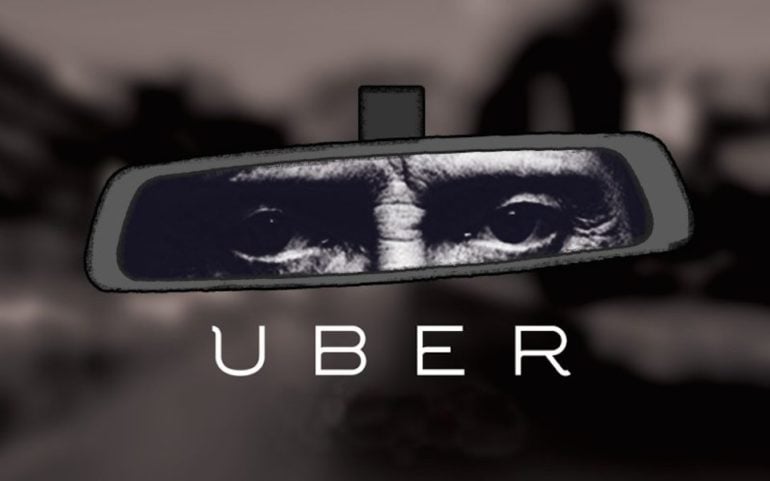The list of Uber’s enemies is a long one. It includes everyone from politicians to taxi lobbyists and the general public to its own drivers. I have been saying on quite a regular basis in the last couple of months that a war is brewing in the transport market.
What I thought I meant by that was below the belt corporate tactics, pushing the boundaries of the legal system and aggressive public relations activities – a dick measuring contest of sorts from a bunch of men that want to show how much money they have at their disposal and how wide and far their personal networks reach. I never thought that things would get physical, until Friday.
Whilst Uber have labelled the ‘citizens arrest’ actions of ‘Arresting Uber’ frontman Russell Howarth upon one of its drivers last week as “a stunt”, my fear is that all actions have consequences. And when a group of people start taking the law into their own hands, shit starts to spiral out of control pretty fast.
ARRESTING UBER
The leader of the ‘Arresting Uber’ movement is Howarth, a registered Uber driver. That’s what makes this situation so intense. This isn’t a case of an external body protesting against innovation – it’s the company’s own early adopters rising up against a new product recently introduced in UberX.
Howarth, the mouth piece for this ‘movement’ describes himself as an ‘industry advocate’ that has been standing up for the taxi and hire car industry for the past 10 years. Howarth says he is an ex London riot-policing squad officer, who also has experience in counter terrorism as well as working with MI6. He now spends his time looking after high profile clients with his hire car services, which is also registered on the Uber platform.
Ironically, Howarth was recently invited by Uber to be an ambassador for the service via email last month.
Howarth told Startup Daily that in a nutshell, Arresting Uber’s goal is to promote safe lawful application of the technology Uber provides. Howarth also clarified that the technology is in no way against the law – instead he takes issue with the manner in which Uber is applying it.
So who exactly are the key stakeholders in this new movement?
Howarth told Startup Daily that support for the movement came from Uber Partners themselves. That is Hire Car drivers on Uber Black and Uber LUX. Howarth claims that many of these drivers are afraid to speak out against Uber for fear of ‘reprisal’. It should be noted though that Howarth has said he has experienced no such thing to date from Uber.
What started out as a movement for NSW based Hire Car (Limousine) industry operators, has quickly started to grow. To date over 3,000 people have signed a petition that ‘Arresting Uber’ is circulating. Howarth told Startup Daily that the movement now has support from other states such as Western Australia, South Australia and Victoria; and now Uber drivers in other cities internationally are getting on board. Howarth claims that France, Spain, United Kingdom and the United States are represented.
“Consumers are also backing the campaign, and becoming concerned once they realise what the issues actually are. Backing has come from professionals in Legal, Banking, Medical and many of the upper-end clientele who are not really UberX customers but would be more likely to utilise UberLUX or UberBlack,” he said.
“Many didn’t know that safety checks were not being done, many even thought the service was actually legal. Some companies have told us they will no longer pay for their employees to use UberX. It is true that most of our support comes from clients who would probably not be a major user, if at all, of UberX.”
This argument in the grand scheme of things is a rather mute point. Companies listen to credit card transactions and cash flow; the opinion of a non-customer would be of no concern to Uber at all.
A $17 BILLION GIANT
Every movement in history started when a group of people began to feel marginalised. It is understandable that hire car drivers that have been active supporters in the formative days of Uber would be pissed at the possibility that they could be replaced by a cheaper alternative – much in the same way that tele-operators in the past have been by outsourcing overseas as well as new telephony technologies.
The problem with the relentless pursuit of profit is that sometimes, people at the top of the food chain become arseholes. At the top of Uber’s foodchain is Founder and CEO Travis Kalanick, widely considered to be one of the best entrepreneurs of our age – and as Sarah Lacy, founder and CEO of Pando Media suggested in a recent feature for Pando Quarterly, one of the biggest arseholes in tech:
It’s a company that prides itself on playing rough and aiming to break laws. It has a self-described “war room” inside its new hard-edged headquarters. It’s played fast and loose with background checks on drivers and with the truth. A Pando investigation earlier this year showed that a driver accused of assault whom the company blindly defended had a criminal record that should have been caught in Uber’s background checks. More recently, it’s hired a campaign manager to shape the company’s narrative. This is an area CEO Travis Kalanick already knows plenty about, if we understand ‘shaping the company’s narrative’ to mean slinging mud and misleading the public in an image war between Uber and taxi companies.
Not only has Uber vilified riders accusing their drivers of rape, assault or general bad behavior, they’ve also betrayed all their drivers; Kalanick has said he can’t wait to replace them all with self-driving cars. Time and again, he’s shown he is loyal to little more than his growing bank account and to the all-mighty free market. The Verge recently exposed a campaign called SLOG, publishing internal documents that detail a plan for agents to pose as passengers to recruit drivers from competitor Lyft and vie to tie up their cars so they couldn’t pick up passengers.
To be fair, when a business scales as fast as Uber has, there are always going to be ‘problem people’ that slip through the cracks. I am 100% certain that Uber is not the first company to let someone in the door with a criminal history, and it definitely won’t be the last.
When I reached out to David Rohrsheim, General Manager of Uber’s Australian operations for comment on the activities and allegations coming from the ‘Arresting Uber’ camp, Startup Daily was told that Uber would be making no comment on the ‘stunt’ (the ‘citizens arrests’). However, on our questions around safety procedures, we were pointed to an April post by Uber Sydney on its standards when it came to ‘ridesharing’ in Australia:
It’s important to us that every ridesharing partner on the Uber system meets, and continues to meet, our rigorous safety standards.
All ridesharing partners must be at least 21 years of age, and drive a registered, 2005 or later model four-door vehicle under a full driver’s licence. All ridesharing partners must also pass a rigorous criminal history police check, as well as undergoing a driving history check provided by the State transport authorities – The Roads and Maritime Services in New South Wales, VicRoads in Victoria, and the Department of Transport and Main Roads in Queensland.
As a minimum, all ridesharing partners are also required to have a current policy of compulsory third party (CTP) and third party property insurance.
But we don’t stop there – we want to ensure that riders, as well as members of the community, are as protected as possible. That’s why all ridesharing partners in Australia are also covered by up to US $5,000,000 contingent coverage for bodily injury and property damage to third parties by a large global insurer rated A+ by A.M. Best.
This means that if, in the event of an accident, a ridesharing partner’s own personal CTP or third party property insurance is exhausted or does not apply for any reason, passengers, pedestrians, other drivers, and the community at large can rest assured knowing that ridesharing partners remain covered by a robust first-class policy.
Whilst the safety narrative from Uber has all its bases covered, the story around working within the realms of legislation has begun to unravel across the states. In May this year, Startup Daily reported that Transport Minister Gladys Berejiklian, on radio with Ben Fordham, practically sat on the fence when it came to the very new concept of the Uber X ridesharing services.
In a 2GB radio interview on Thursday night, Berejiklian said there was no problem unless Uber called itself a ‘taxi service’: ”You don’t want to limit people’s choice because, at the end of the day, it does come down to choice.”
However, just last week on the 16th of October, in another 2GB interview with Ben Fordham, Berejiklian confirmed that the government’s and indeed the office of Roads and Maritime Services (RMS) position on the Uber X services had changed, when presented with a question by a listener, who also happened to be a taxi driver.
Caller: What efforts are being made by yourself and the government, in relation to our competitor Uber, who have come out with full force, that are taking our work, putting unauthorised drivers on the road, that’s allowing them to compete [as if they’re] cab drivers, without any registration, without any endorsement and without any approval by the government. What are you going to do about it?
Berejiklian: Michael, thankyou very much for the question, and can I say, what we’ve done [to date] is that drivers doing that we are recognising as illegal drivers, so we’ve actually fined a lot of them already, so drivers …
Fordham: How many have you fined roughly?
Berejiklian: Oh, I can get you the stats after I hang up
Fordham: That’s alright
Berejiklian: But RMS does that, but we’ve been determined to ensure that anyone driving illegally, and in those circumstances you are, gets pinged for it
Whilst this seems quite finite, I am still bewildered at the way the commentary around this has changed in the past few months – when the laws have in fact, not changed. Section 37 of the NSW Passenger Transport Act 1990 is quite clear on the expectations for private hire car drivers. The big question is whether Uber X is in fact a hire car service, or a ride sharing service – obviously at this point the ‘Arresting Uber” movement and the government don’t see it as the latter.
When it comes to this fight, Uber has three very strong, almost indestructible assets going for it. The first is demand. People want Uber’s services – all of them, including Uber X. Just like with any business, there will be a plethora of haters and they will more than likely start using Ridesurfing – the Australian answer to Lyft – Uber’s major competitor in the United States.
The second is deep pockets. Uber has the cash to defend themselves if they feel they need to. Being aware of campaigns against your company and choosing which campaigns to squash is a strategy and a smart one. If the time comes, Uber can go head to head and out-cash their opponent.
The third is that Uber is a master at polarisation. And nothing attracts more people to join your cause than a loud hater, people that love Uber, will continue to love Uber. If and when the day comes that Uber do something so morally reprehensible then they should be worried, for the moment, even though many drivers have been accused of what can only be described as gross atrocities – the community still recognises a difference between company and individual workers – as they should.
YOU’RE UNDER ARREST
This week, following on from his first (and only thus far) citizens arrest, Howarth has committed to arresting a minimum of 10 Uber X drivers.
“Next week I am committing to apprehending and bringing before a person authorised to deal with the matter (the police or the courts) at least 10 [Uber X] drivers. I may do many more. I have worked out that I can easily detect 10 offences a day,” Howarth told Startup Daily.
“Interestingly, Uber is banning any account I use to make a booking. [Some] of these are legitimate customers of Uber who use Uber but support the cause that Uber X should be legalised. I intend to use more legitimate customers to book my rides that detect the offences and subsequently arrest those drivers.”
Frankly, trying to kill a giant from the bottom up is a stupid tactic – one that is full of risk and danger to all involved. I don’t know about you, but if some bloke came up to me and told me they were placing me under a citizen’s arrest, I wouldn’t be cooperating.
In an age where tensions are already high in the world for so many different reasons, the likelihood of some serious shit going down once someone chooses to challenge Howarth’s tactics is where things go from ‘movement’ to assault charges. Howarth told Startup Daily that he will use no more force than necessary when executing a ‘citizen’s arrest’ – something that is covered in our own laws.
Law Enforcement (Powers and Responsibilities) Act 2002 No 103231
Use of force in making an arrest
A police officer or other person who exercises a power to arrest another person may use such force as is reasonably necessary to make the arrest or to prevent the escape of the person after arrest.
In regards to the mechanics of the ‘citizen’s arrests’ to take place, Howarth told Startup Daily that, “Once a decision has been made to arrest an individual for an offence and I’m satisfied that the evidence is there and I am acting lawfully I accept there is a possibility the person may not be happy about that. The law is quite clear”.
Howarth continues, “If the arrest is lawful then it should be affected. No more force should be used than is necessary and I expect that most drivers, albeit driving illegally, will not want to make their own situation worse. I expect that most drivers or Uber staff (as I will be looking at arresting them soon too once I identify the offences and have the required proof) will not resist arrest. That is unlawful behaviour in itself. The arrest will be 100% lawful. I shall act responsibly and I shall immediately take the person, and any property found on the person, before an authorised officer to be dealt with according to law”.
“Were a person aggrieved by me arresting them, instead of resisting arrest unlawfully, they ought make a complaint to police alleging deprivation of liberty, which is a very serious offence, at which time the police would investigate whether or not the arrest was indeed lawful. I am confident that I am absolutely operating within the law and I will continue to do so. I will not engage in unlawful tactics. I am aware and it has been widely reported on that Uber has used immoral and unlawful (making thousands of fake booking of competitors for instance and wasting thousands of drivers time) tactics in their meteoric rise but I do not wish to engage in the same.”
Whilst Howarth, clearly someone who knows what he is doing in regards to ‘arresting’ another in a responsible manner, may pull off all these ‘arrests’ without incident, the more pressing issue at the table is the tone that sets for the ‘Arresting Uber’ campaign.
Whilst the stories on the ‘Arresting Uber’ website pertaining to incidents such as an Uber X driver running over a 6 year old girl, another driver abducting and assaulting a woman, an Uber X driver bashing a person with a hammer and many other quite widely reported stories are true, a little digging would find that the same could be said for many large global companies and industries across the world, and these stories ARE spread far and wide across different cities. To single out the Uber X service as being a powder keg of rapes, bashings and murders is classic ‘movement’ propaganda and does nothing to serve the core issue that seems to be at the heart of the cause – fairness.
In fact, such propaganda only serves to heighten the level of passion stakeholders feel for the cause, and passion clouds the logical mind. Before you know it, once the leader of the campaign has notched up a few successful ‘citizen arrests’ others begin to follow suit. The variables from individual to individual begin to change and before you know it a ‘citizen’s arrest’ turns into one party being carted away in a body bag.
We need to remember, Uber X drivers are just trying to make ends meet too. Why should they have to go to work each day fearing a passenger placing them under arrest?
WHAT ABOUT RIDESURFING?
So where does Ridesurfing fit into all this? Do the different payment structures between Uber X and Ridesurfing get them off the hook, because they are a driven by a ‘donation’ based economy?
Howarth told Startup Daily at this point he had no plans to target Ridesurfing drivers: “Ridesurfing actually are not committing the offence as Uber X is. They are more P2P based. Let’s be honest – calling [Uber X] ‘Ride-Sharing’ is a nonsense…” he said.
“Traditionally, ride-sharing was about person A was going form A to B and hooked up with someone in the community heading close to B for an environmental benefit and it just made sense – a small contribution towards fuel and wear and tear made and every wins. Great concept! Uber X and Ridesurfing are an entirely different proposition”.
I couldn’t disagree more with that outlook, and I feel that perhaps ‘Arresting Uber’ grossly underestimates the Ridesurfing team, and who they have as a financial backer – namely, Rocket Internet. I have stated before that Ridesurfing are the anti-Uber; and whilst co-founder Manutea Dupont disagreed with those remarks instead telling Startup Daily he was focused on building a strong community – I maintain my position.
The difference between Ridesurfing and Uber X is not the fact that the former is a donation-based system; it’s selling the perception that Ridesurfing is a tight knit community and UBER is not. While Ridesurfing may only be clocking up hundreds of rides a day at the moment in comparison to Uber’s thousands, they are growing fast and building a strong loyal community and should not be dismissed as ‘just’ a P2P service quite so easily.
BACK TO THE LAW
As I stated before, the government has in fact changed their mind on the absent laws around ‘Ridesharing’ since the beginning of the year. Earlier in the year they were on the fence as to what actually classified ‘Ridesharing’. That is where all the confusion started, and tensions began to escalate.
There may be some good news to come for both Uber X and Ridesurfing, along with (hopefully) some much needed clarification around what exactly constitutes ‘Ridesurfing’. Last month, a panel working on the government’s Competition and Policy Review delivered their draft report. Among the recommendations included a specific mention about transportation applications. The draft report recommends the government sides with innovation and customer demand:
Mobile technologies are emerging that compete with traditional taxi booking services and support the emergence of innovative passenger transport services. Any regulation of such services should be consumer-focused and not inhibit innovation or protect existing business models.
It should also be mentioned that this draft report is the first in over 20 years around Competition and Policy. The draft report continued, singling out Uber:
The emergence of Uber has been particularly controversial as regulatory agencies have been questioning its legality and fining drivers, notwithstanding considerable public demand for its services. This indicates existing regulation is more concerned with protecting a particular business model than being flexible enough to allow innovative transport services to emerge.
National Seniors Australia notes that new technologies are having the effect of empowering consumers:
[T]he digital revolution — including the growing use of mobile telephone applications in combination with satellite navigation technologies — is giving rise to opportunities for new entrants to breakdown existing taxi network monopolies, enabling consumers to exercise greater choice and receive prompter service. It will be important to ensure that these innovations are not stifled by further anti-competitive regulation aimed at protecting incumbents . . .
Whether or not these recommendations remain in the final report remains to be seen. From there, they still need to be implemented, and clarification around the way legislation defines ‘Ridesharing’ needs to become finite.
Until that happens, the war wages on.
Featured image: Arrestinguber.com





















Trending
Daily startup news and insights, delivered to your inbox.